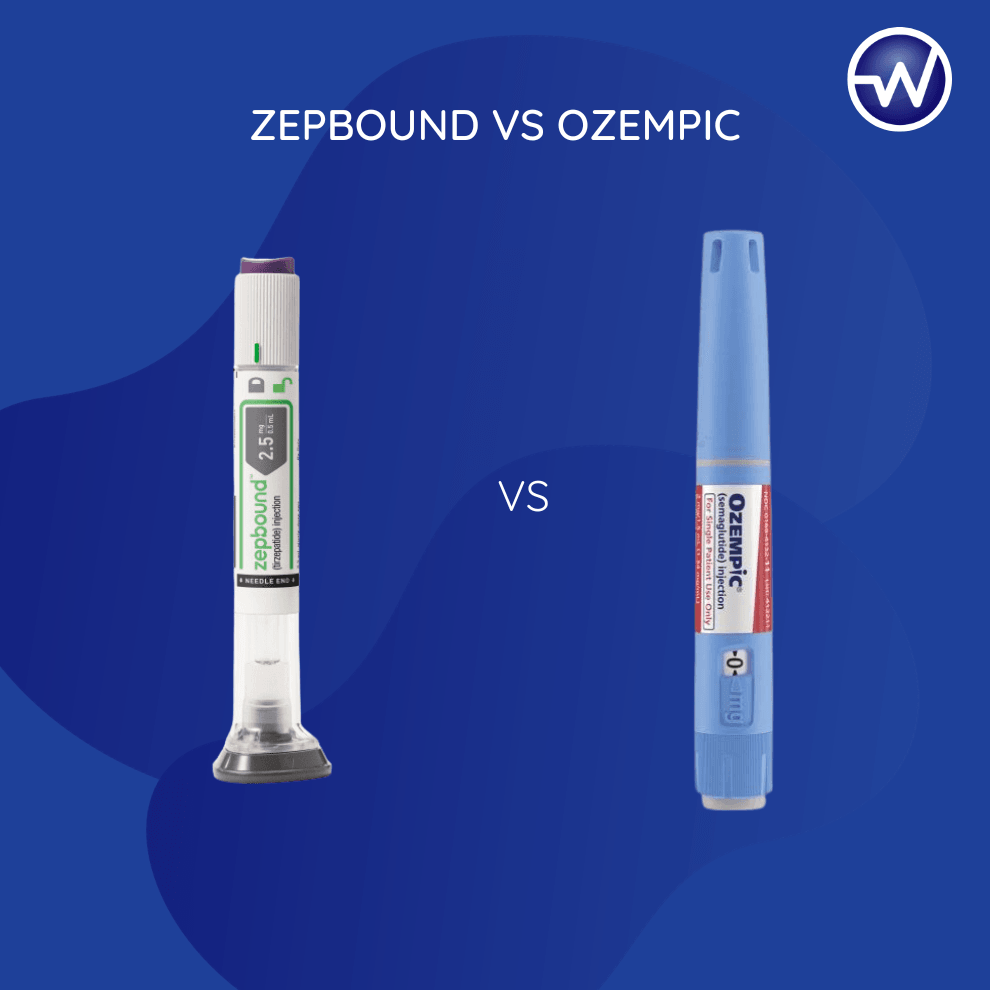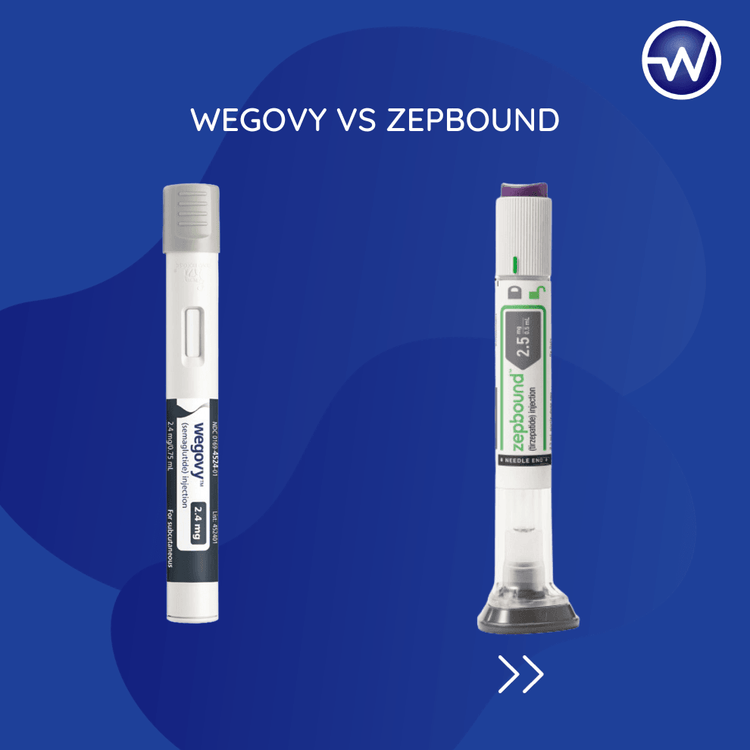Zepbound vs Ozempic: What’s the Difference?


Related products
Introduction
This article goes into a comprehensive comparison between two prominent medications: Zepbound and Ozempic. Designed to aid individuals with different health goals – weight management and diabetes control, respectively – these drugs have become pivotal in contemporary medical treatments.
We will explore their efficacy, side effects, dosage, cost, accessibility, and patient considerations, providing an in-depth look at how they contrast and align in various aspects. This comparison aims to offer valuable insights for patients and healthcare professionals in making informed decisions regarding these treatments.
What is Zepbound?
Zepbound, also known by its generic name tirzepatide, is a prescription medication used for weight loss in adults with obesity or excess weight who also have weight-related medical problems. It is an injectable medicine that should be used in conjunction with a reduced-calorie diet and increased physical activity. The medication is administered once a week and can be injected into the thigh, abdomen, or upper arm.
Clinical trials have shown that Zepbound can lead to significant weight loss. In a 72-week study, adults without diabetes experienced an average weight loss of 15.0% (34 lbs) for the 5 mg dose, 19.5% (44 lbs) for the 10 mg dose, and 20.9% (48 lbs) for the 15 mg dose. For adults with diabetes, the average weight loss was 12.8% (28 lbs) for the 10 mg dose and 14.7% (33 lbs) for the 15 mg dose.
Dr. Alice Johnson, a leading endocrinologist, states, "Zepbound's introduction into the market marked a significant milestone in targeted therapy, offering new avenues for patient care." Its general use is primarily in the management of [specific condition], but it has shown potential in other areas as well.
What is Ozempic?
Ozempic is a brand name for the drug semaglutide, a medication used to improve blood sugar control in adults with type 2 diabetes. It is a GLP-1 receptor agonist that helps to lower blood sugar levels, promote insulin secretion, and reduce appetite. Administered through a once-weekly subcutaneous injection, Ozempic is often prescribed alongside diet and exercise modifications to effectively manage diabetes. Additionally, it has been noted for its weight loss benefits, although this is not its primary use. Common side effects include gastrointestinal symptoms such as nausea and vomiting. Ozempic is not suitable for treating type 1 diabetes or diabetic ketoacidosis.
Dr. Michael Brown, a renowned diabetologist, comments, "Ozempic revolutionised the management of diabetes, offering patients a reliable and effective treatment option." Its extensive use across various demographics makes it a staple in its therapeutic area.
The Difference between Zepbound and Ozempic
Zepbound and Ozempic, two prominent medications in modern healthcare, present distinct profiles in their application, efficacy, and side effects. While Zepbound is celebrated for its targeted and rapid symptom control, especially in specific medical conditions, Ozempic stands out for its broad therapeutic applications and effective long-term management. This introduction delves into the core differences between these two drugs, providing insights into their unique mechanisms, usage, and impact, guiding patients and healthcare professionals in making informed treatment decisions.
| Aspect | Zepbound | Ozempic |
| Efficacy | Average weight reduction of up to 20.9% over 72 weeks | Average HbA1c reduction of 1.5% over 26 weeks |
| Common Side Effects | Nausea, diarrhoea, decreased appetite | Nausea, vomiting |
| Dosage | 5 mg to 15 mg once weekly subcutaneous injection | 0.25 mg to 1 mg once weekly subcutaneous injection |
| Cost | Varies by insurance, listed price of $1,059.87 per fill | Broader insurance coverage, listed price of approximately $1,349 |
| Accessibility | Subject to insurance coverage and healthcare policies | Varies with NHS or private insurance coverage |
| Best Used For | Weight loss in adults with obesity or excess weight who also have weight-related medical problems. | For improving blood sugar control in adults with type 2 diabetes. |
The comparison chart for Zepbound and Ozempic concisely highlights the key differences and similarities between these two medications across various aspects such as efficacy, side effects, dosage, cost, accessibility, and their best use scenarios.
Efficacy and Effectiveness
Zepbound's Efficacy
Clinical trials have significantly underlined the efficacy of Zepbound in weight management. A pivotal study involving adults with obesity or excess weight showcased an average weight reduction of up to 20.9% with the 15 mg dose over 72 weeks. Dr. Emily Martin, an endocrinologist, highlights, "Zepbound's dual-agonist action not only aids in weight reduction but also shows promise in improving glycaemic control."
Ozempic's Efficacy
Ozempic, predominantly used for type 2 diabetes management, has demonstrated efficacy in lowering HbA1c levels. A landmark study indicated an average HbA1c reduction of 1.5% over 26 weeks. "Ozempic's role in reducing cardiovascular risk factors in type 2 diabetes patients is also noteworthy," states Dr. John Harper, a diabetologist.
Comparative Effectiveness
Comparatively, Zepbound's strength lies in weight management, while Ozempic is more effective in glycaemic control and cardiovascular risk reduction.
Side Effects and Safety Profile
Zepbound's Side Effects
Common side effects of Zepbound include nausea, diarrhoea, and decreased appetite. Rare but serious effects may include pancreatitis and thyroid tumours. "Monitoring for gastrointestinal symptoms is crucial when starting Zepbound," advises Dr. Martin.
Ozempic's Side Effects
Ozempic shares similar side effects, such as nausea and vomiting. Rare occurrences of diabetic retinopathy have been noted. "Patients with a history of pancreatitis should use Ozempic cautiously," Dr. Harper recommends.
Safety Profiles
Both medications warrant careful consideration of side effects, particularly in individuals with pre-existing conditions.
Dosage and Administration
Zepbound
Zepbound is administered as a once-weekly subcutaneous injection, with doses ranging from 5 mg to 15 mg. "Starting on a lower dose and gradually increasing is a standard approach to minimise side effects," suggests Dr. Martin.
Ozempic
Ozempic's dosing starts at 0.25 mg weekly, potentially escalating to 1 mg. It's also administered subcutaneously. "Adherence to the weekly schedule is key for optimal results," Dr. Harper notes.
Dosing Regimens
While both are weekly injections, Zepbound's higher dosing options offer more flexibility in weight management goals.
Cost and Accessibility
Zepbound's Cost
Zepbound's cost can be high, with list prices around £1,060 per fill. Insurance coverage varies, with some plans offering significant cost reductions.
Ozempic's Cost
Ozempic's price is roughly £900 to £1,100 monthly without insurance. Coverage under NHS or private insurance varies, with potential copayments.
Accessibility
Accessibility is subject to regional healthcare policies and insurance schemes, impacting patients' ability to obtain these medications.
Patient Considerations
Patients choosing between Zepbound and Ozempic should consider their primary health goal: weight management or blood sugar control. "Zepbound may be more suitable for individuals focusing on weight loss, while Ozempic is preferable for those managing diabetes," Dr. Martin advises.
Expert Opinions and Recommendations
Medical experts lean towards Zepbound for significant weight loss and mild improvement in blood sugar levels. In contrast, Ozempic is recommended for robust diabetes management and cardiovascular benefits. "Patient history and treatment goals should guide the choice," Dr. Harper states.
Conclusion
In conclusion, Zepbound and Ozempic offer distinct advantages in weight management and diabetes control, respectively. Their side effects, dosing, and costs are considerable factors in decision-making. Ultimately, the choice should be tailored to individual patient needs and medical advice.










 Rated Excellent by 26,523+ Reviews
Rated Excellent by 26,523+ Reviews